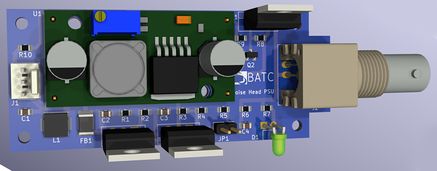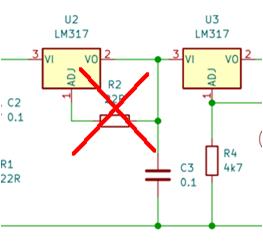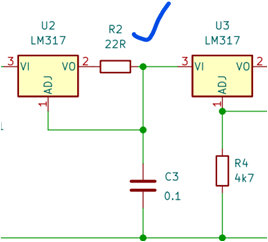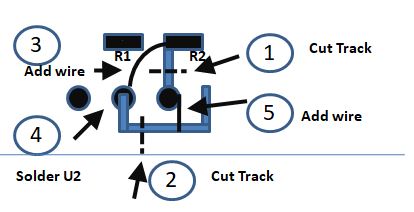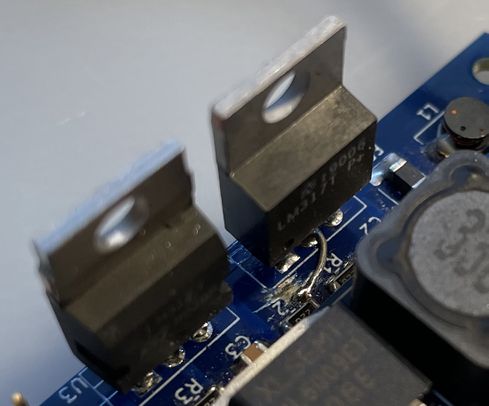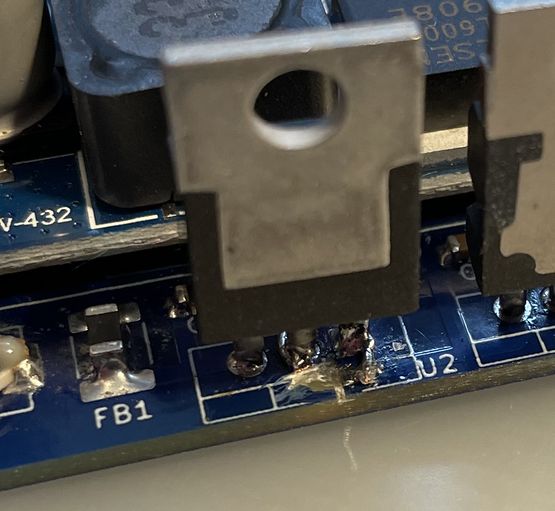Difference between revisions of "Noise Source PSU"
| (8 intermediate revisions by 2 users not shown) | |||
| Line 1: | Line 1: | ||
| − | This simple unit is designed to switch a 28v (or 12v) supply for a Noise Source and be controlled by the Portsdown NF Meter. The input switching signal is 0v for the "off" state and 3.3v for the "on" state. | + | This simple unit is designed to switch a 28v (or 12v) power supply for a Noise Source and be controlled by the Portsdown NF Meter. The input switching signal is 0v for the "off" state and 3.3v for the "on" state. |
| − | + | [[File:Noise Head PSU.jpg|437px]] | |
| − | The Bill of Materials is here. | + | [[File:NF_Schematic_Extract.JPG|917px]] |
| + | |||
| + | The full schematic is here [[:Media:NoiseHeadPSU.pdf]] | ||
| + | |||
| + | The Bill of Materials is here. [[:File:NF Switch BOM.xlsx]] | ||
| + | |||
| + | ===Design and Operation=== | ||
| + | |||
| + | The Noise Source PSU has 4 distinct circuit functions: | ||
| + | |||
| + | ====Voltage Step-up==== | ||
| + | |||
| + | An eBay booster converter is used to derive a 33v supply from the incoming 12v. The actual input voltage is not critical, it should be in the range 5 - 25v. L1 and C1 reduce the amount of hash fed back down the supply line. FB1, R1 and C2 provide extra smoothing on the output. The potentiometer on the eBay booster converter should be set for 33v output if a 28v Noise Source is being used. If a 12v Noise Source is being used, the output should be set to 17v. | ||
| + | |||
| + | ====Current Limiting==== | ||
| + | |||
| + | The first LM317T (U2) is used to limit the current in the event of a short-circuit (or worse, connection of the output to a 50 ohm attenuator). R2 sets the current limit to 56ma, and C3 provides a low impedance input to the next stage. | ||
| + | |||
| + | Note that the early batch of PCBs had pins 1 and 2 (Adj and Vout) of U2 transposed; the modifications to the PCB to iorrect this are set out below. The unit will function without the modifications, but the current limit will not operate. | ||
| + | |||
| + | ====Voltage Regulation==== | ||
| + | |||
| + | The second LM317T (U3) regulates the output voltage to 28v. If jumper 1 is made, the output voltage is set to 12v. | ||
| + | |||
| + | ====Switching==== | ||
| + | Q1 is a p-channel mosfet and is used to switch the supply on and off. The switching signal (from GPIO pin 26 on the Portsdown Raspberry Pi 3 or 4) turns an NPN transistor on or off to switch the MOSFET. The exact types of transistors are not critical. The MOSFET should be able to handle 100ma and 30v. The NPN transistor needs to be able to handle 30v. | ||
| + | |||
| + | ===Construction=== | ||
| + | |||
| + | The PCB is designed to fit in a Die-cast box with a BNC for the output socket. This is the standard connector for commercial nNoise Sources. The input supply and switching is fed through a grommet into the box. | ||
| + | |||
| + | Note that none of the regulator or transistor tabs should be connected to the Die Cast box. If there is risk of them touching the box, then insulation tape or an insulating washer should be used to prevent this happening. | ||
| + | |||
| + | ===Measured Performance=== | ||
| + | |||
| + | The prototype drew 35 ma at 12v without a noise head connected, and 75ma with the noise head connected and permanently on. Average current drain during operation was about 55ma. | ||
| + | |||
| + | The current limiting was measured at 56ma; a typical noise head drwas 10ma. | ||
===Error on the First Batch of PCBs=== | ===Error on the First Batch of PCBs=== | ||
| Line 11: | Line 48: | ||
The unit functions if assembled with the error, but the current limit will not work correctly. | The unit functions if assembled with the error, but the current limit will not work correctly. | ||
To correct the error, the PCB should be modified as shown below, or pins 1 and 2 on U2 should be swapped. | To correct the error, the PCB should be modified as shown below, or pins 1 and 2 on U2 should be swapped. | ||
| + | |||
| + | [[File:Incorrect wiring.png|263px]] [[File:Correct wiring.png|268px]] | ||
| + | |||
| + | To modify the PCB, first cut the tracks 1 and 2 and scrape away the solder resist adjacent to the middle hole for U2 and the second cut. Then add wire link 3. Solder in U2 (LM317T) being careful not to displace the wire link. Then add wire link 5. | ||
| + | |||
| + | [[File:NF Switch PCB Mod.JPG|414px]] | ||
| + | |||
| + | |||
| + | After Modification: | ||
| + | |||
| + | [[File:Repair 1.jpg|489px]] | ||
| + | |||
| + | Cut track 1 and wire link 3 | ||
| + | |||
| + | [[File:Repair 2.jpg|555px]] | ||
| + | |||
| + | Cut track 2 and wire link 5 | ||
Latest revision as of 17:00, 10 December 2021
This simple unit is designed to switch a 28v (or 12v) power supply for a Noise Source and be controlled by the Portsdown NF Meter. The input switching signal is 0v for the "off" state and 3.3v for the "on" state.
The full schematic is here Media:NoiseHeadPSU.pdf
The Bill of Materials is here. File:NF Switch BOM.xlsx
Design and Operation
The Noise Source PSU has 4 distinct circuit functions:
Voltage Step-up
An eBay booster converter is used to derive a 33v supply from the incoming 12v. The actual input voltage is not critical, it should be in the range 5 - 25v. L1 and C1 reduce the amount of hash fed back down the supply line. FB1, R1 and C2 provide extra smoothing on the output. The potentiometer on the eBay booster converter should be set for 33v output if a 28v Noise Source is being used. If a 12v Noise Source is being used, the output should be set to 17v.
Current Limiting
The first LM317T (U2) is used to limit the current in the event of a short-circuit (or worse, connection of the output to a 50 ohm attenuator). R2 sets the current limit to 56ma, and C3 provides a low impedance input to the next stage.
Note that the early batch of PCBs had pins 1 and 2 (Adj and Vout) of U2 transposed; the modifications to the PCB to iorrect this are set out below. The unit will function without the modifications, but the current limit will not operate.
Voltage Regulation
The second LM317T (U3) regulates the output voltage to 28v. If jumper 1 is made, the output voltage is set to 12v.
Switching
Q1 is a p-channel mosfet and is used to switch the supply on and off. The switching signal (from GPIO pin 26 on the Portsdown Raspberry Pi 3 or 4) turns an NPN transistor on or off to switch the MOSFET. The exact types of transistors are not critical. The MOSFET should be able to handle 100ma and 30v. The NPN transistor needs to be able to handle 30v.
Construction
The PCB is designed to fit in a Die-cast box with a BNC for the output socket. This is the standard connector for commercial nNoise Sources. The input supply and switching is fed through a grommet into the box.
Note that none of the regulator or transistor tabs should be connected to the Die Cast box. If there is risk of them touching the box, then insulation tape or an insulating washer should be used to prevent this happening.
Measured Performance
The prototype drew 35 ma at 12v without a noise head connected, and 75ma with the noise head connected and permanently on. Average current drain during operation was about 55ma.
The current limiting was measured at 56ma; a typical noise head drwas 10ma.
Error on the First Batch of PCBs
The Initial batch of PCBs for the Noise source power supply had one error. The Vout and Adj pins on the current-limiting LM317T (U2) were reversed. The unit functions if assembled with the error, but the current limit will not work correctly. To correct the error, the PCB should be modified as shown below, or pins 1 and 2 on U2 should be swapped.
To modify the PCB, first cut the tracks 1 and 2 and scrape away the solder resist adjacent to the middle hole for U2 and the second cut. Then add wire link 3. Solder in U2 (LM317T) being careful not to displace the wire link. Then add wire link 5.
After Modification:
Cut track 1 and wire link 3
Cut track 2 and wire link 5
